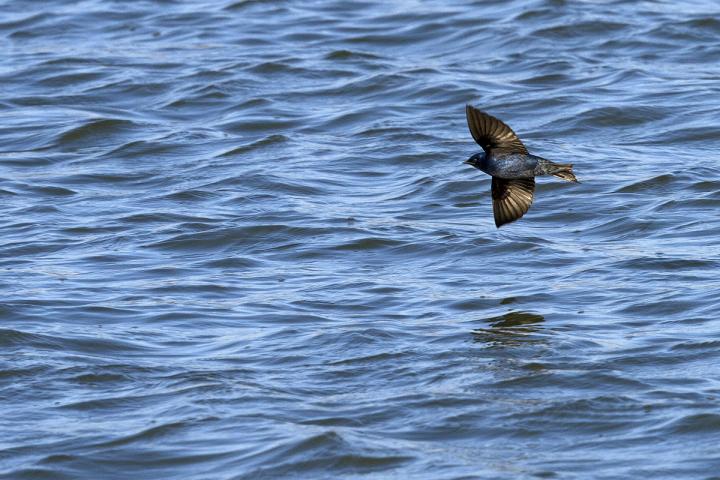
Credit: Photo by Michael Jeffords and Susan Post
CHAMPAIGN, Ill. — Purple martins will soon migrate south for their usual wintertime retreat, but this time the birds will be wearing what look like little backpacks, as scientists plan to track their roosting sites along the way.
The researchers recently discovered that purple martins are roosting in small forest patches as they migrate from North America to Brazil. The scientists published their findings in the Journal of Field Ornithology.
“This is highly unusual behavior for songbirds, which typically roost in heavily forested areas,” said Auriel Fournier, a co-author of the study with University of Manitoba biological sciences professor Kevin Fraser, who led the research. Fournier is the director of the Forbes Biological Station at the Illinois Natural History Survey.
“It’s surprising to see them roosting in these forest islands, which are small, isolated clusters of trees typically surrounded by agriculture, water or recently cut forest,” Fournier said.
The researchers want to determine whether the birds are responding to a change in the environment or whether their surprising roosting behavior is something purple martins have always done.
“We believe they must be intentionally seeking out the forest islands,” Fournier said. “Because these habitats don’t occur very frequently on the landscape, the birds’ use of them is unlikely to be by chance.”
“We are curious if birds are choosing these isolated patches of habitat because they have fewer predators than in larger patches of forest,” Fraser said.
About 13% of the world’s birds are colonial nesters, and purple martins are the only songbird species that requires a nest site surrounded by the nests of other similar birds, the researchers said.
“During migration, these birds flock in numbers up to the hundreds of thousands,” Fournier said. “It’s wild because their flocks are sometimes big enough to be detected by radar.”
The researchers had to wait for technology to catch up before they could identify precisely where the birds were stopping to rest during migration. A purple martin weighs about 1.6 ounces (45 grams) and flies an estimated 6,200 to 13,700 miles (10,000 to 22,0000 kilometers) a year. Too much additional weight – even that of a tiny tracker, for example – could interfere with the bird’s trek.
Thanks to advances in technology, the scientists are using GPS tracking devices small enough to be carried by purple martins. The devices use satellites to pinpoint the birds’ location with such accuracy that Fraser and Fournier can identify down to a single tree where a tagged purple martin is roosting at night during migration.
“No one has looked at habitats during migration,” Fraser said. “But we need to look so that we can start protecting these birds and their habitats across international boundaries.”
The researchers plan to continue tracking purple martins, monitoring whether they faithfully return to the same roosting sites in forest islands. And they are working with conservation groups across this species’ range to better preserve purple martin habitat.
###
The scientists published their findings in the Journal of Field Ornithology.
The INHS is a division of the Prairie Research Institute at the University of Illinois.
This research was supported by the University of Manitoba; the Natural Sciences and Engineering Research Council of Canada; the Disney Conservation Fund; the Purple Martin Conservation Association; the U.S. Department of Energy/National Nuclear Security Administration in cooperation with Consolidated Nuclear Security, LLC; and the Tom Ridge Environmental Center Foundation.
Editor’s notes:
To reach Auriel Fournier, call 217-300-8698; email [email protected].
To reach Kevin Fraser, call 204-474-7044; email [email protected].
The paper “Precise direct tracking and remote sensing reveal the use of forest islands as roost sites by purple martins during migration” is available online and from the U. of I. News Bureau
DOI: 10.1111/jofo.12298
Michael Jeffords and Susan Post are wildlife photographers and research affiliates of the Illinois Natural History Survey at the Prairie Research Institute of the U. of I. Their photographs are available here.
Media Contact
Tiffany Jolley
@LASillinois
217-333-5802
Original Source
https:/
Related Journal Article
http://dx.




